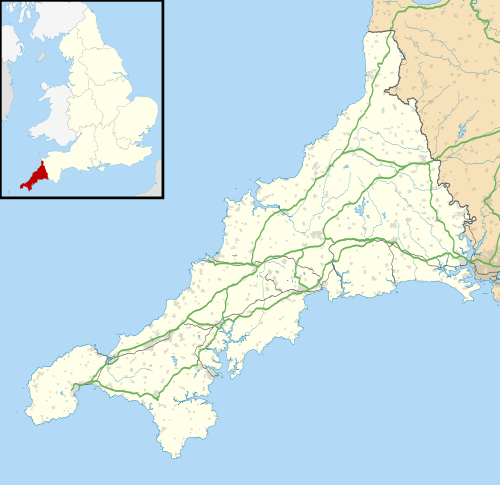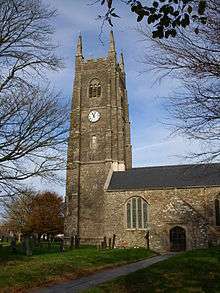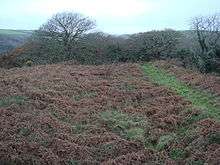Kilkhampton
Kilkhampton (Cornish: Kylgh)[1] is a village and civil parish in northeast Cornwall, England, United Kingdom. The village is on the A39 about four miles (6 km) north-northeast of Bude.[2]
Kilkhampton
| |
|---|---|
 Kilkhampton Location within Cornwall | |
| Population | 1,368 (Civil Parish, 2011) |
| OS grid reference | SS253113 |
| Civil parish |
|
| Unitary authority | |
| Ceremonial county | |
| Region | |
| Country | England |
| Sovereign state | United Kingdom |
| Post town | BUDE |
| Postcode district | EX23 |
| Dialling code | 01288 |
| Police | Devon and Cornwall |
| Fire | Cornwall |
| Ambulance | South Western |
| UK Parliament | |


Kilkhampton was mentioned in the Domesday Book as "Chilchetone". The population of the parish was 1,193 in the 2001 census.[3] This increased to 1,368 in the 2011 census [4]
The remains of a late Norman period motte-and-bailey castle known as Penstowe Castle are located 500 metres west of the village. Further west, at Stowe is the site of Stowe House, the grand mansion of John Granville, 1st Earl of Bath, built in 1680 but demolished in 1739: some of the stonework was reused at Penstowe, also in the parish.[5]
Kilkhampton has a post office, a primary school, and a community centre called the Grenville Rooms. There are three general stores, two pubs, and a selection of shops including an electrical goods store. There is also an MOT test station and an agricultural supply depot. The village was surveyed for the Survey of English Dialects.
A crater on Mars has been named Kilkhampton.
History
The manor of "Chilchetone" was very valuable at the time of Domesday Book. It had paid tax on 7 hides in the previous reign and there was land for 40 ploughs. 26 villagers and 23 smallholders had 26 ploughs between them and there was also 30 acres (120,000 m2) of meadow, 20 sq furlongs of pasture and a considerable woodland. The livestock were 50 cattle, 600 sheep, 20 pigs and 40 goats; the annual value was £18.[6]
Kilkhampton Church
Kilkhampton Church, with its magnificent Norman south doorway and lofty buttressed Perpendicular tower of eight bells, is dedicated to St James the Great and is at least 450 years old. But some historians claim parts of it to be around 1000 years old. It is one of many churches dedicated to this saint on a pilgrims' route, which leads ultimately to Santiago de Compostela in northern Spain. The church contains an impressive monument to the Cornish hero Sir Bevil Grenville. Other features of interest are the south porch (dated 1567), a fine series of benchends of the first half of the 16th century. (The benchends are from the same workshop as those of Launcells and Poughill.)[7]
The tenor bell was found to be cracked in 2006: after repairs, it was re-hung and the full peal of eight bells were first heard again on Sunday 23 September 2007.
Notable residents
See also People from Kilkhampton
- The England rugby union captain Phil Vickery grew up in the village and his family still own a substantial amount of the surrounding farmland
- Thomas Greenway, Premier of the Canadian province of Manitoba until 1908, was born in the village.
- Sir Bevil Grenville, Royalist commander in the Civil War
References
- Place-names in the Standard Written Form (SWF) : List of place-names agreed by the MAGA Signage Panel. Cornish Language Partnership.
- Ordnance Survey: Landranger map sheet 190 Bude & Clovelly ISBN 978-0-319-23145-6
- GENUKI website. Retrieved April 2001
- "2011 census. Retrieved Feb 2015".
- Pevsner, N. (1970) Cornwall, 2nd ed. Penguin Books
- Thorn, C. et al. (eds.) (1979) Cornwall. Chichester: Phillimore; entry 1, 4
- Pevsner, N. (1970) Cornwall, 2nd ed. Penguin Books
External links
| Wikimedia Commons has media related to Kilkhampton. |
